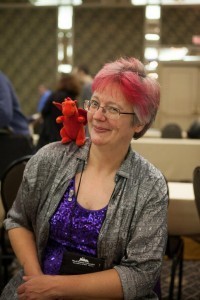Cat Rambo's Blog, page 71
July 28, 2013
What Colors for Worldcon? You Decide.
 I’m headed to LoneStarCon3 at the end of August and here’s some of what I’m looking forward to:
I’m headed to LoneStarCon3 at the end of August and here’s some of what I’m looking forward to:
Participating in a couple of group readings
The chance to pick up my copy of Beyond the Sun from Bryan Thomas Schmidt
The Glitter and Mayhem party. I want to do something worthy of it, so I’ve decided to add a couple more colors to my usual pink (explained in The Pink Hair Manifesto) just for WorldCon and let YOU decide the color. Just vote in the comments. The top three colors will get at least a streak’s worth of hair. If you are supporting me in the Clarion West Write-a-thon, even by just a dollar (which also gets you a bonus stack of fine fiction), your vote counts ten times as much. Everyone who votes gets entered to win a copy of the book or a piece of the Near + Far jewelry.
Here’s your options, all Manic Panic colors:
After Midnight
Atomic Turquoise (currently at 2 votes)
Bad Boy Blue
Blue Moon (currently at 10 votes)
Electric Amethyst
Electric Banana
Electric Lava
Electric Lizard
Electric Tiger Lily (currently at 1.5 votes)
Enchanted Forest
Fuchsia Shock
Green Envy
Infra Red
Lie Locks
Mystic Heather
New Rose
Pillarbox Red
Pretty Flamingo (currently at .5 votes)
Psychedelic Sunset
Purple Haze (currently at 31 votes)
Raven
Red Passion
Rockabilly Blue
Rock and Roll Red
Shocking Blue (currently at .5 votes)
Sunshine
Ultra Violet
Vampire Red
Vampire’s Kiss
Venus Envy
Violet Knight (currently at .5 votes)
Voodoo Blue (currently at 1 vote)
Wildfire (currently at .5 votes)
July 27, 2013
Last Week of the Clarion West Writeathon: Reward for Donors
 It’s the last week of the Clarion West Write-a-thon! Donate now and you’ll get the donors reward, a file in the format of your choice containing all the writing I’ve done over the course of the Write-a-thon plus a couple of bonuses.
It’s the last week of the Clarion West Write-a-thon! Donate now and you’ll get the donors reward, a file in the format of your choice containing all the writing I’ve done over the course of the Write-a-thon plus a couple of bonuses.
Donate as little as a dollar and get (the package so far):
Short story “Rappacini’s Crow” (steampunk horror)
A haiku about blackberries
Short story “Elections at Villa Encantada” (urban fantasy)
Flash piece “The Facts: A Zombie Story”
A still untitled military fantasy piece
Short story “Primaflora’s Journey” (secondary world fantasy)
Bonus – The first 50 pages of Queen of the Fireflies, a literary horror novel
Even if you don’t want to sponsor me, check out some of the other fine writers participating in the Writeathon!
Self Promotion and Career Building: What I Told the Clarion West 2013 Class
 Yesterday I spent a pleasant chunk of time talking to the Clarion West 2013 students, along with Django Wexler. Django and I were the “mystery muses,” a Friday feature for the CW students where people come in to chat about a specific aspect of the writerly life. Django spoke well to the experience of having one’s first major book come out, since his book (which I have read and heartily recommend) The Thousand Names just came out. He let us all know (to mass disappointment) that it doesn’t lead to being booked on the Leno or Daily Show or lavish book tours, though he did get to go to ComicCon.
Yesterday I spent a pleasant chunk of time talking to the Clarion West 2013 students, along with Django Wexler. Django and I were the “mystery muses,” a Friday feature for the CW students where people come in to chat about a specific aspect of the writerly life. Django spoke well to the experience of having one’s first major book come out, since his book (which I have read and heartily recommend) The Thousand Names just came out. He let us all know (to mass disappointment) that it doesn’t lead to being booked on the Leno or Daily Show or lavish book tours, though he did get to go to ComicCon.
I decided to talk about self-promotion and career building, since that’s advice I didn’t get a lot of while at Clarion West myself. And I came up with nine maxims, but lost that index card so I have an incomplete list. Maybe the students can chime in to tell me what I’ve forgotten.
Writing always comes first. Self-promotion can become a form of procrastination, particularly if you’re playing on Facebook or Twitter while pretending it’s all in the name of self-promotion. Having the biggest Twitter following in the world won’t help you unless you’ve actually got something to promote.
Be discoverable. One of the questions that always comes up in my Building an Online Presence for Writers class is whether it’s mandatory for a writer to have a social media presence and blog and all that. The answer is no, (though it’s helpful in these days, when the burden of promotion falls increasingly on the writer him or herself.) But you do need a way for someone to find you if they liked a story and want to contact you. That may be a simple static webpage where you maintain a list of your publications. It may be a full blown blog. Or it might be a social media presence (although I think this approach is not the best, because people may not be on Twitter or Tumblr or Facebook or whatever network you’ve chosen).
Don’t oversell. We’ve all unfriended or stopped following people because of the unrelenting way they push their books. Out of five Tweets (or blog posts, or FB posts, or whatever), only one should be about selling stuff. The others can be kitten pictures, advice, funny sayings, whatever (one easy way to fill this quota is to promote other people), but make it something that people are interested in.
Don’t be a jackass. It’s a small world and word gets around when you behave badly. Search on “authors behaving badly” if you want some examples. Professionality is important, although sometimes it’s easy to lose sight of in our charming, silly, opinionated genre. Don’t make arguing on the Internet another form of procrastination.
Jealousy is okay. We all experience it. Use it as motivation for writing. Don’t put it on the Internet. Find one person you can trust and use them as your sounding board when you absolutely have to say those snarky things about an award or kudos bestowed unjustly.
Say thanks. When someone does something kind like getting you invited to an anthology, blurbing your book, whatever, don’t assume it’s your due because you’re a genius. We all think we’re geniuses. SF is full of people paying it forward, but they’re more likely to do so for gracious people.
Be kind to yourself. Writers are so good at beating ourselves up, at feeling guilty for not doing X or achieving Y. Don’t do that. Set goals but rather than punishing yourself for not meeting them, reward yourself when you do hit that word count. You are the person with the most to gain from being kind to you, so do at least one nice thing for yourself each day, whether it’s taking time for some activity you enjoy or giving yourself some small present.
Don’t be a jackass. It’s a point worth repeating.
Some other things that got mentioned:
Find someone who is where you want to be a few years down the line and look to see what they’re doing, using their example to guide your actions.
Early on, you don’t need to go to conventions unless they’re something you enjoy for their own sake. If you do go, participate. If you can’t be on panels, try volunteering, which is a great way to meet people and network.
Writing process differs from person to person. Try different strategies and when you find something that works for you, do it, do it, do it.
For most of us, it’s easier to write if you get at least a few words in each day.
It is often skill in rewriting that differentiates the professional-level writer from the almost-but-not-quite-there.
And here’s something I didn’t mention, but which has come up a lot recently, as to what to blog about, both in terms of finding something interesting and not spending too much time on it: excerpts of what you’re working on both fulfills those terms and encourages you to get some words out.
July 22, 2013
A Smorgasbord of Speculative Fiction: August 16, 2013, 8 pm, at the Wayward Coffeehouse
 On August 16, 2013, at 8 p.m., Seattle’s Wayward Coffeehouse (6417 N. Roosevelt WAY NE, #104, Seattle, WA) will host a reading of four of the area’s notable speculative fiction writers. Ted Kosmatka, J.M. Sidorova, Django Wexler, and Cat Rambo will read from new and forthcoming work.
On August 16, 2013, at 8 p.m., Seattle’s Wayward Coffeehouse (6417 N. Roosevelt WAY NE, #104, Seattle, WA) will host a reading of four of the area’s notable speculative fiction writers. Ted Kosmatka, J.M. Sidorova, Django Wexler, and Cat Rambo will read from new and forthcoming work.
The four readers share something beyond a love of speculative fiction — they are all represented by the same agent, Seth Fishman of the Gernert Company. After meeting during the Locus Awards recently hosted in Seattle, the four joined forces for a joint reading at the Wayward Coffeehouse. Their work ranges from epic fantasy to hard SF.
About the readers:
Ted Kosmatka’s work has been reprinted in nine Year’s Best anthologies, translated into a dozen languages, and performed on stage in Indiana and New Work. He’s been nominated for both the Nebula Award and the Theodore Sturgeon Memorial Award and is co-winner of the 2010 Asimov’s Readers’ Choice Award. His novel The Games was nominated for a Locus Award for Best First Novel. He grew up in Chesterton, Indiana and now works as a video game writer.
Cat Rambo lives, writes, and teaches by the shores of an eagle-haunted lake in Redmond, Washington. Her 200+ fiction publications include stories in Asimov’s, Clarkesworld Magazine, and Tor.com. Her short story, “Five Ways to Fall in Love on Planet Porcelain,” from her story collection Near + Far (Hydra House Books), was a 2012 Nebula nominee. Her editorship of Fantasy Magazine earned her a World Fantasy Award nomination in 2012.
J.M. Sidorova is a fiction writer and a biomedical scientist at the University of Washington. She is a graduate of the Clarion West workshop for writers of speculative fiction. Her science fiction and fantasy short stories appeared in Clarkesworld, Asimov’s, and other venues. Her debut novel The Age of Ice (Scribner/Simon & Schuster) has just arrived at bookstores.
Django Wexler graduated from Carnegie Mellon University in Pittsburgh with degrees in creative writing and computer science, and worked for the University and artificial intelligence. Eventually he migrated to Microsoft in Seattle, where he now lives with two cats and a teetering mountain of books. His latest book is the first of an epic fantasy quintet, The Thousand Names.
July 13, 2013
From WIP – Queen of the Fireflies
 Was fiddling this for a writing retreat I’m doing in September. This is from the beginning.
Was fiddling this for a writing retreat I’m doing in September. This is from the beginning.
June, 1976, Indiana
On Indiana summer evenings, the fireflies begin their dance as dusk creeps over the landscape, reducing green to gray and black and brown. Their lights are yellow as sunlight or neon; they blink among the hedges and maneuver a few inches above the tall grass. There are five varieties of fireflies native to the Northern Indiana region. Each signals prospective mates with specific timing, and no four second interval firefly would approach a six second interval one.
On the same summer evenings, the mosquitoes whine, though only the female ones, hovering before landing on unsuspecting arms and ankles, draining as much as they can before either taking off, heavy and bloated with their sanguine plunder, or else are splattered and exploded by their victim when he or she notices not the sting of the needlelike proboscis being inserted, but the tickle of their feet among the fine, downy hair arms.
Other creatures come out later: soft-nosed rabbits and the tiny bats that flitter around lampposts, devouring the night insects swarming there. Possums drag their heavy bodies along, investigating garbage cans and quarreling with the raccoons come to plunder. There are even rats, in some places along the St. Joseph River, water rats that move through the green-brown water, searching among the slimy weeds that coat the bottom. But the fireflies are already there: they have marked the coming of the night, lighting as though protesting the approaching darkness.
Michigan Street crosses down from the state of Michigan, comes through Northern Indiana and splits one of its larger cities, South Bend, like a splayed bird. Corn fields and alfalfa lie further out but here the street slashes the city’s belly, unfolds layers like the dark verge of Notre Dame University, the struggling downtown, the unsavory brew further south of town as you headed down to the smaller towns: Lakeville, Lapaz, Plymouth. Far to the south it reaches Kokomo, later Indianapolis, then the nether region of the state, which hosted the revival of the Ku Klux Klan in the twenties.
July 8, 2013
Making the Most of GoodReads
 (This originally appeared on the SFWA blog.)
(This originally appeared on the SFWA blog.)
Goodreads is the largest reader community site in the world, with over thirteen million members. Goodreads was recently acquired by Amazon, creating worries that the site would change, but Amazon has said they do not intend to make changes. Users can track their reading, find or make book recommendations, and discuss what they’re reading. Goodreads lists self-published books as well as those from professional presses.
Goodreads reaches outside its own site, supplying reviews to Powell’s Books, USA Today, the Los Angeles Public Library, the Columbus Metropolitan Library, and Kobo, among others. It supplies lists of books to the popular website Listopia, such as “Best Books of 2012.”
Beyond that, however, Goodreads offers authors tools that they can use to promote books. Using Goodreads, you can create giveaways, post excerpts, and help Goodreads readers discover your books.
When someone joins Goodreads, they create a profile that shows their reading side. Your profile includes optional information such as a photo, location, date of birth, website, reading interests, and a brief bio. Fill it out but be aware that after you’ve added an author profile, the second profile will be what most people see, rather than this one.
Goodreads allows you to maintain lists of what you’ve read, what’s on your to-read list, and what you’re currently reading. Each of these is referred to as a shelf.
You also have a newsfeed, which is displayed on your Goodreads home page, and shows recent news from friends and authors you are following as a fan. You can see what Goodreads events they are attending, whose reviews they are following, when they rate, add, or review a book, and so forth.
As a writer, you can expand your basic profile by adding an author profile and joining the over sixty thousand authors participating in the Goodreads author program. How do you add an author profile? It’s simple. Find one of your books on Goodreads and look for the “Is this you?” link at the bottom. Click on that to claim the book. It will take a few days for Goodreads to confirm you are the author, but they will mail you when your profile has been updated.
Now that you’re a Goodreads author, you’ve got access to a dashboard of new and interesting tools. On the home page, click on “Visit your dashboard,” which should appear near the top on the righthand side. The page that opens up should have Author Dashboard up in the top righthand side under the Goodreads toolbar. You’ll see it displays stats like number of works, which is the number of works attributed to you, and the number of fans and friends.
That section may seem a little mystifying. What’s the difference between “added by unique users,” “fans,” and “friends”? When you are looking at someone’s profile, you can opt to become a fan or add them as a friend. (If they’re not a Goodreads author, the option to add them as a friend will not appear. Goodreads automatically creates pages for authors.) If you are friends with someone, both people have to have approved the relationship, and each will have their reviews and comments displayed in the other’s newsfeed. If you are a fan of someone, their reviews, comments and blog posts will appear in your newsfeed, but they will not see yours. Added by unique users does not affect your newsfeed at all but is the number of people who have added one or more of your works to one of their shelves.
You’ll see all of your works listed in the “My Books” section under your statistics, along with statistics for each, including the number of ratings, the average rating, the number of Goodreads reviews, how many people have it on their to-read shelf, and how many people have it on their currently-reading shelf. You can drill down on each listing: while I don’t believe you can currently add ebooks, you can edit the book’s information and see Goodreads statistics for how many people have added, rated, reviewed, or included that title on their “to-read” list.
Beneath that is your blog. I am still looking for an easy way to push a WordPress blog post to one’s Goodreads blog, but so far I haven’t found one. There are plenty of Goodreads related WordPress plugins (http://wordpress.org/extend/plugins/t...) but the majority of them allow you to display data from Goodreads on your site, such as a list of what you’re currently reading. Generally I mirror a few, but not all of my blog posts, here, because it’s a pain in the butt.
One of the most useful Goodreads Author Tools is their Giveaway system. Go to their giveaway page and you’ll see a wide variety of giveaways, which you can sort by which are ending soon, which are most requested, which are from popular authors, and what’s been recently listed. Goodreads makes it very easy to enter giveaways and allow requesters to add the book to their to-read shelf/. You can set the dates for the giveaway, as well as what countries it’s available in, if you don’t want the cost of shipping something overseas. It does not cost anything to list a giveaway, but be prepared to follow through. You cannot give away e-books as a giveaway, so you will have to bear the cost of shipping.
This is handy because Goodreads promotes the giveaways for you. Over 40,000 users sign up for giveaways on a daily basis, according to Goodreads, which means that mentions of your giveaway are appearing in the newsfeeds of their friends, as well as being accessible from the main giveaway page.
For the best experience, I suggest going through GoodRead’s Author Tutorial, as well as the abundance of other documentation they’ve provided. You’ll want to investigate groups as well as how to run an author Q&A. You can create trivia questions that drive interest in your book or publicize book signings and other promotional events. You may want to add some of its widgets to your blog or website or even pay to use its Self-Serve Advertising platform.
(If this was useful to you, consider taking my next Creating an Online Presence for Writers class, which covers additional book-based social networks like Shelfari and LibraryThing as well as how to best use them. Find out more by clicking “Take an Online Class with Cat” at the top of the page.)
July 5, 2013
Why Podcast?
The human associated with this fine dragon is Goldeen Ogawa (http://www.goldeenogawa.com/).
This Sunday, Folly Blaine and I are teaching another podcasting class. Here’s the description:Podcasting Basics
Podcasts, both audio and video, are an increasingly popular way to reach an audience. In this two hour session, learn what you need to know to record and edit your own podcast, how to promote your podcast, and what equipment and software to use. As Folly Blaine, Christy records and acts as Podcast Manager for Every Day Fiction, and has also recorded podcasts for Beneath Ceaseless Skies, Wily Writers, and This Mutant Life; Cat is the former fiction editor of Fantasy Magazine and has recorded podcasts for Clarkesworld, Beneath Ceaseless Skies, and Fantasy Magazine. Limited enrollment – reserve a slot now!
Sunday, 9:30-11:30 AM PST, July 7
$99
Why might you be interested in podcasting and learning to do your own? Here’s a few reasons:
It’s a good way to reach a new set of readers. Many of the people who listen to podcasts prefer that to finding your stuff in text form inline. They’ll listen to your story in the car, while exercising, while working, and other places where text isn’t convenient. And they’re always looking for new, good stuff.
It’s a great way to polish your reading aloud skills. As a writer you’ll need to do readings. We’ll give you some tips in the class, but the best way to get better at it? Practice.
It makes you comprehend your work in a new way. I always read aloud stories as a last step in polishing them. Combine that with recording a podcast and you’re examining your work in order to figure out how it sounds.
Last week, my agent told me that authors who record their own books see a significant bump in sales, but that publishing houses don’t like to have them do it, because they’re unsure of the quality. If you can point to previous podcasting experience, you can back up the suggestion that you read your own work and even have samples of what you can do.
When publicizing “Five Ways to Fall in Love on Planet Porcelain,” I made sure it was available in audio form. Did that help earn it a Nebula nomination? I don’t know, but it certainly didn’t hurt.
Classes are online – you need a computer with a microphone, and it’s preferable to have a web cam (most new computers have this built in). It’s pretty painless, and if you haven’t used Google Hangouts before, you may be as enchanted with the technology as I am by the end.
Interested in signing up? Mail me at catrambo AT gmail.com.
June 27, 2013
Teaser: Another Excerpt from A New Board is Elected at Villa Encantada
 Here’s another chunk from “A New Board is Elected at Villa Encantada,” (working title) a darkly humorous story about a very odd condo complex that I’ve written several stories about already. It’s been fun filling out the complex’s roster a little in this story, and I’m going back to revise one of the unpublished ones with some of these details. Like the talking cacti.
Here’s another chunk from “A New Board is Elected at Villa Encantada,” (working title) a darkly humorous story about a very odd condo complex that I’ve written several stories about already. It’s been fun filling out the complex’s roster a little in this story, and I’m going back to revise one of the unpublished ones with some of these details. Like the talking cacti.
Even the cacti garden was talking about the assessment. I usually don’t visit down there, in the little rock garden near the lake. For one thing all of the cacti like to talk at once. They ramble and they repeat and they are altogether too fond of puns. Not for the first time, I wondered what exactly the magician who had created them had had in mind. Had it really been a dozen cranky plants, whose extreme longevity led them to be highly opinionated about everything?
There are twelve cacti altogether, eleven in pots and one who has chosen to plant itself and grow. The eleven in pots have opted for mobility over size. They were fond of making Rumpelstiltskin wheel them about the complex in order to enjoy the sun and fresh air.
Each was distinctive, both in personality and appearance. They had names, which usually mattered only to each other. I had mentally bestowed nicknames on them: Bombast, Furor, Humblepie, Obscuro, Smarmy, Weasel, Johnny Nonsense, Earnest, Hairyfoot, Splainer, and the unpotted Old Dignity, a massive saguaro towering a good fifteen feet over its much shorter, hideously root bound, compatriots.
Bombast said, “It’s a cabal! They’ve been waiting to seize power for years now, and rob our reserves, turn us over to some real estate agent so the complex can be demolished for a high rise.”
Furor said, “Don’t be ridiculous. They’re not organized enough to be a cabal. And this place isn’t zoned for high-rises.” It added, its tone dark, “No, what they have in store for us is much, much worse.”
“How can they hope to understand the history of the complex?” demanded Hairyfoot. “Most of them haven’t even been here a decade.”
I considered them. The complex was odd at the best of times. It was a refuge, a complex that didn’t mind people who were outside the ordinary. That led to a population that was more mixed than most, including the denizens of this garden.
Earnest said to me, “Did you give your proxy to someone to vote?”
I shook my head and fled.
Rumpelstiltskin was by the dumpster, sorting out recyclables. He looked wretched and smudgy as an old sheet of newsprint. As I passed, he looked up, and said, hopefully, “What’s my name?”
“Not today,” I said. “You won’t escape today.”
I felt guilty at the look on his face, and the situation made me itch, but it’s been so hard to find a maintenance man here that I could understand why they had done it. Sometimes when you find good help, you have to rely on the laws of magic to keep them from leaving. Unscrupulous? Yes, undoubtedly. But the needs of the many outweigh those of the few. Or the one, in his case.
If you want to read the rest of the story, you can get it, along with at least six other stories, at the end of July by signing up to sponsor me in the Clarion West Write-a-thon. Even a small donation entitles you to the stories, so please do sign up!
April 29, 2013
Writing at the Next Level: Getting Inside Your Character’s Head
Once you’ve mastered the basics of getting words on a page and moving characters around through situations, there’s some things that (in my experience) the majority of writers need to focus on. Examples are narrative grammar, paragraphing strategies, trimming excess from sentences, and getting inside a character’s head. Here, I’m going to discuss the last of those.
A lot of this is taken from correspondance with my student Hasnain. He’d asked about story structures, particularly Freitag’s Triangle, and we’d discussed where the triangle occurs in Junot Diaz’s story, Fiesta 1980. In looking at his most recent story, I’d said I thought he needed to get inside his main character’s head more.
Hasnain asked: You mentioned today that going into the narrator’s head is a good thing since it helps the reader seat more firmly with the narrator. However, here’s where I am a bit confused. I read somewhere that what people think and feel should be shown in a sensory way through their actions and interactions with others. If I go into the narrator’s head, wouldn’t I be telling? In my story, this would be if the narrator thinks about how he wants to put Sal’s love to the test.
My reply:
Let’s go back to Fiesta. Here’s some places where I think we’re particularly inside the narrator’s head and seeing his thoughts.
We were all dressed by then, which was a smart move on our part. If Papi had walked in and caught us lounging around in our underwear, he would have kicked our asses something serious.
Rafa gave me the look and I gave it back to him; we both knew Papi had been with that Puerto Rican woman he was seeing and wanted to wash off the evidence quick.
Not that me or Rafa loved baseball; we just liked playing with the local kids, thrashing them at anything they were doing. By the sounds of the shouting, we both knew the game was close, either of us could have made a difference.
But even that little bit of recognition made me feel better.
This was how all our trips began, the words that followed me every time I left the house.
Another possible way to do this is by showing the thoughts on the page as words that echo what’s going through the narrator’s mind. Here I’m going to refer you to a piece of mine that appeared in Clarkesworld Magazine, The Worm Within, and hope you’ll forgive me for using my own stuff, but it’s easier to go to it for examples than hunt around for other stories.
Here’s a few passages where I’ve used that technique (note that it’s also an unreliable narrator – being inside the head of an unreliable narrator is a tricky strategy but awesome when effective):
Nude, I revel in my flesh, dancing in the hallway to feel the body’s sway and bend. Curved shadows slide like knives over the crossworded tiles on the floor, perfect black and white squares. If there were a mirror I could see myself.
I don’t know where he lives in my body. Surely what feels like him winding, wormlike, many-footed and long-antennaed through the hallways of my lungs, the chambers of my heart, the slick sluiceway of my intestines — surely the sensation is him using his telekinetic palps to engage my nervous system. I think he must be curled, encysted, an ovoid somewhere between my shoulder blades, a lump below my left rib, a third ovary glimmering deep in my belly.
I walk in the park. Where did all these robots come from? What do they want? They look like the people that built them, and they walk along the sidewalk, scuffed and marred by their heavy footsteps. They pretend. That’s the only thing that saves me, the only thing that lets me walk among them pretending to be something that is pretending to be me.
Present tense works very well for this, I’ve found. Here, as another example, is an extended passage from the novel I’m grappling with:
The blade slices so close to my eyeball that my upper eyelashes brush against it. I pull back from that silver line hanging sideways in the air, roll on my heels on the gritty tiles.
The crowd is silent, watching from the vast stands. Not that many of them here, for a challenge match, particularly one no one thinks Crysa can win. But the fact that the Duke is here, watching, brings many.
Snap my left fist forward. Almost catch her.
Almost drive the side of the little round shield into her ribs as I push towards her. But she goes left, dodges with an exhalation that hangs in the frosty air between us.
Bitch is quick and fast as that Champion in the Southern Isles.
Built like her too.
Not as experienced, though. Spring’s always represented by someone young. Fresh.
She’s off balance from the step. Weight on that heel.
Make as though to kick forward into the other. Sweep a foot backward, into her calf. Make her falter.
You can even go so far as to mark thoughts as thoughts, usually by italicizing them.
Here’s a couple of passages from Jeff VanderMeer’s Finch, where we hear Finch’s thoughts:
Am I dead? he thought sometimes, walking down that green carpet he remembered from a different city, a different time. Am I a ghost?
Six in the afternoon. Time to leave. He packed Heretic’s list in a satchel and holstered his miserable gun. Watched Blakely and Gustat put on spore gas masks “just in case.” Just in case of what? Just in case there’s one fungus in the whole damn city you haven’t been exposed to yet?
Stephen King is a master of this. Here’s a lovely, complicated bit of it in Salem’s Lot. It’s a three part structure: A) a description of what he’s thinking about, followed by b) bits of the Catholic prayer for the dead repeating itself in his head and then c) a reference to the words of a profane ritual conducted earlier in the book. They’re designated with tokens of punctuation, such as italics and parentheses. 123, 123, 123, and so on, deliberate as any dance step:
The Catholic prayer for the dead began to run through his mind, the way things like that will for no good reason. He had heard Callahan saying it while he was eating his dinner down by the brook. That, and the father’s helpless screaming.
Let us pray for our brother to our Lord Jesus Christ, who said…
(O my father, favor me now.)
He paused and looked blankly down into the grave. It was deep, very deep. The shadows of coming night had already pooled into it, like something viscid and alive. It was still deep. He would never be able to fill it by dark. Never.
I am the resurrection and the life. The man who believes in me will live even though he die…
(Lord of flies, favor me now.)
Yes, the eyes were open. That’s why he felt watched. Carl hadn’t used enough gum on them and they had flown up just like window shades and the Glick kid was staring at him. Something ought to be done about it.
…and every living person who puts his faith in me will never suffer eternal death…
(Now I bring you spoiled meat and reeking flesh.)
What do you think? How many of these devices have you used?
(If this interested you, you might consider taking one of my online classes, particularly the Literary Techniques for Genre Fiction class.)
April 15, 2013
Giveaway: Near + Far Hardcover Edition, Plus Three Pieces of Jewelry
So in honor of the occasion, I’m giving away one of the hardcovers, along with three pieces of jewelry using the Near + Far interior art by Mark Tripp. Three winners will be picked: one will get both book and jewelry, the other two a piece of the jewelry.
What do you have to do to be entered? Evangelize the book
Link somewhere on the Internet (Facebook/G+/Twitter/your blog/(relevant) comments section of another blog/Stumbleupon/whatever) to Near+Far’s page on my website and leave a comment here or on the original post to let me know that you’ve done it.
If you’d like to listen to some of the stories in audio form, here’s a recently updated list of the ones I know of.
The giveaway ends at 11:59 PM PST on Sunday, April 21, and winners will be announced on Monday, April 22.




